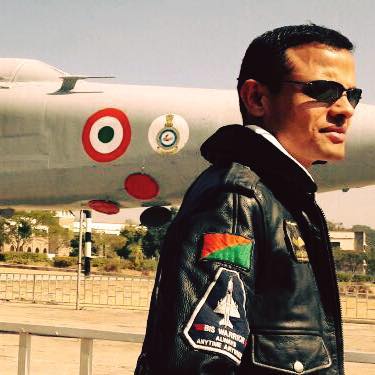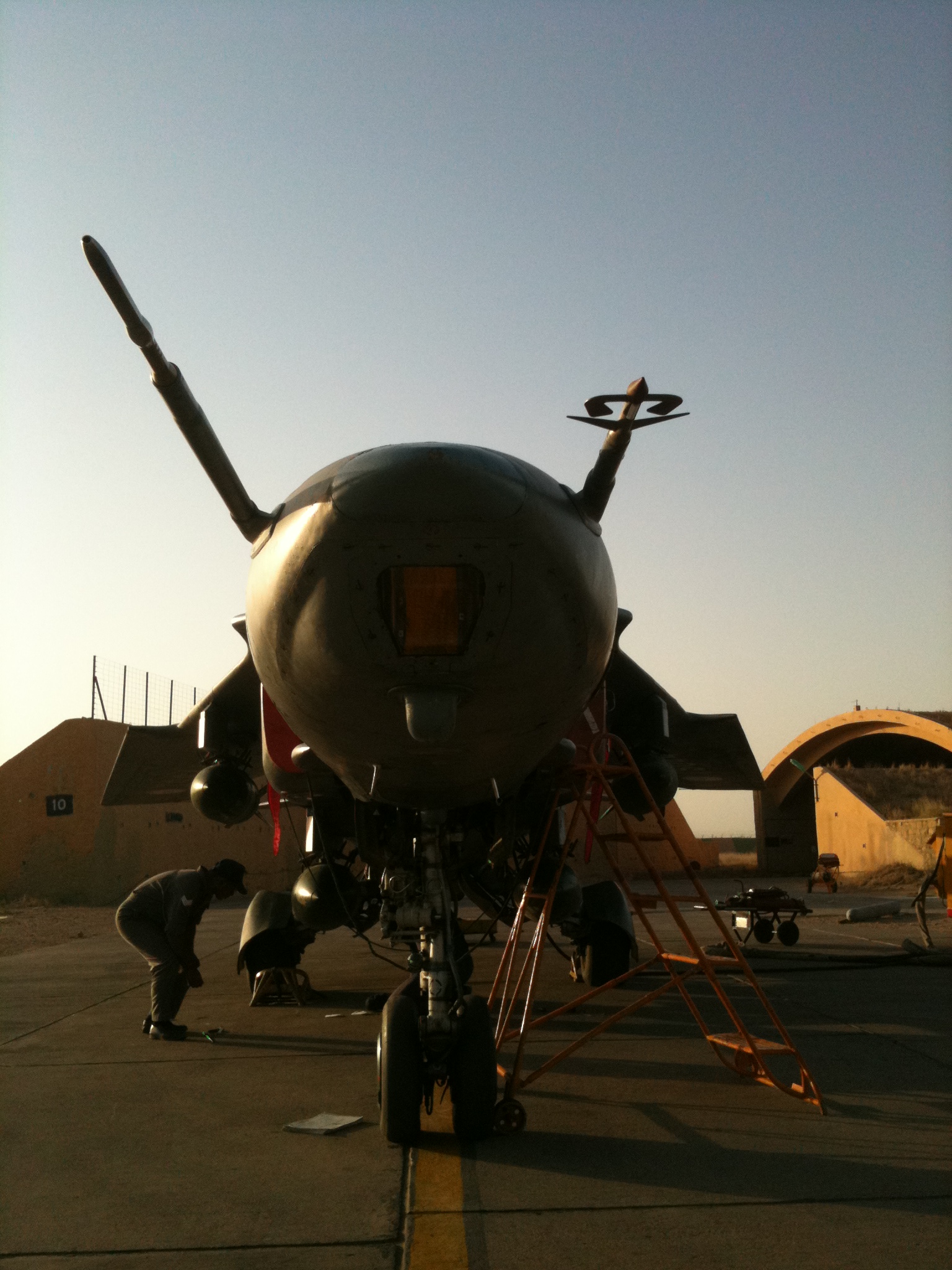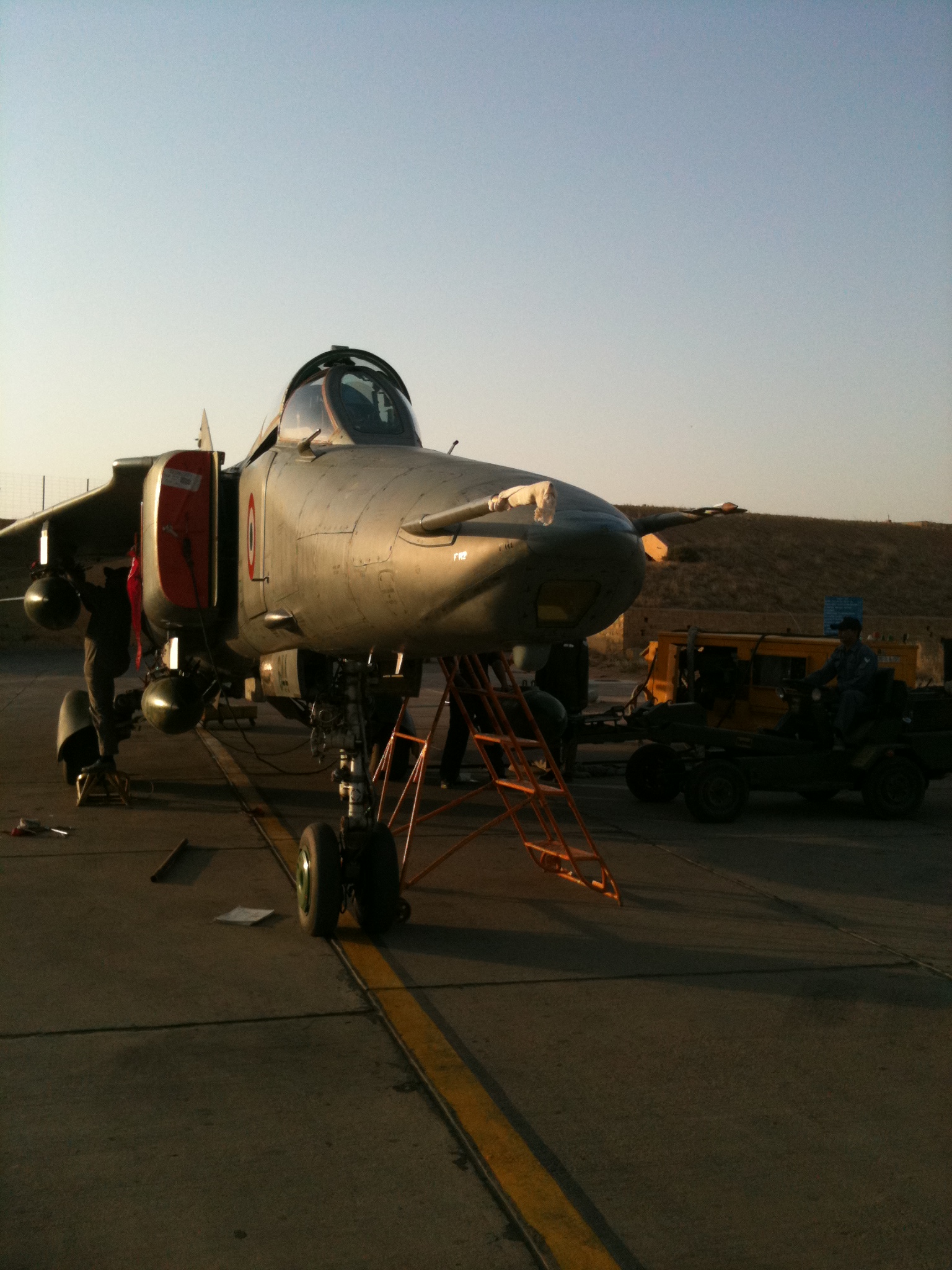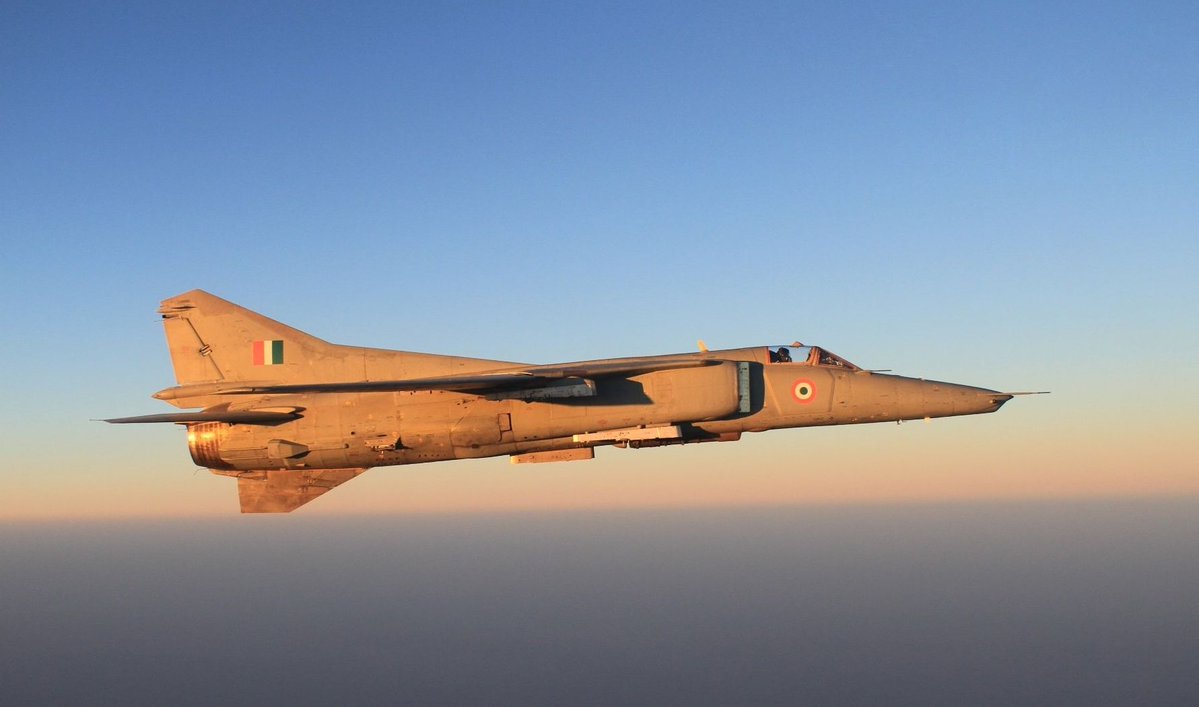Flying and fighting in the MiG-27: Interview with a MiG pilot

Fast, brutal and unforgiving, the MiG-27 is a formidable Soviet attack aircraft that continues to serve with the Indian Air Force. Hush-Kit spoke to former MiG-27 pilot Anshuman Mainkar about flying and fighting in this ferocious machine known locally as the Bahadur.
 What is the best thing about the MiG-27? “She was built for low level flying. No doubt about it, she offered a silk smooth ride down low. And she was fast….I remember a live fire exercise mission flows in card with two French Mirages trailing. On being given a call to push, we engaged afterburners and pulled away from the Mirages, who couldn’t catch up with us after that.”
What is the best thing about the MiG-27? “She was built for low level flying. No doubt about it, she offered a silk smooth ride down low. And she was fast….I remember a live fire exercise mission flows in card with two French Mirages trailing. On being given a call to push, we engaged afterburners and pulled away from the Mirages, who couldn’t catch up with us after that.”
“She was very fast at low-levels, and her ability to hold steady was superb. With wings swept back fully and speeds exceeding 1000 km/h at low levels, the wings waggled and the noise and vibrations that set in gave an impression of a banshee just freed, screaming with abandon.”
What were you first impressions of flying the MiG-27?
“The MiG-27 you got to fly, after doing dual conversion on the MiG-23UB trainer, which was very different from the MiG-27. Firstly, the MiG-23UB stands with its nose up, making visibility on ground difficult for a short guy like me. I had to use two cushions to prop myself up decently. But the switches and their placement in the cockpit were not very different from a MiG-21 which made things easier. True, it was a different generation, so there were other things to contend with, but similar aesthetics made adjustment easy.
It was heavier than the MiG-21. I remember using both hands to control attitude after retracting flaps on the take-off leg during the initial few sorties. Visibility was generally poor, but cockpit workload during the conversion phase did not leave much room or time to take in the scenery.
The big difference of course, was the variable sweep wings, which you had to control manually in the air. We usually flew at 45 degree sweep, extending the wings to 16 degrees for landing/take-off and to 72 for getaways. During the initial sorties, there were a couple of instances when one forgot to sweep wings. But the aircraft gave a few indications (vibrations, sluggish turning) before the trainer captain got a chance to add your name in the little black book and claim a crate of beer.
The circuit speeds were comparable to the MiG-21, and the landing speeds were a notch lesser, flaring out at approx. 310-300 kmph.
The MiG-27, in comparison was set low, had the duck nose and afforded amazing visibility (in relative terms). Handling was similar, but it was much more fun to fly, also considering the lack of patter from the rear cockpit ☺. It handled nicely, although it was heavier than the MiG-21. She was a little stiff to manoeuvre, but once you got the hang of it, she’d follow you to high heaven. Larger than the MiG-21, she also gave you more time in the air, which was welcome, although, built for low levels, the non-existent air-conditioning below 6000 ft made a huge announcement when you landed, and got out, dripping wet from aircraft.
She was very fast at low-levels, and her ability to hold steady was superb. With wings swept back fully and speeds exceeding 1000 km/h at low levels, the wings waggled and the noise and vibrations that set in gave an impression of a banshee just freed, screaming with abandon.”

Which three words best describe the MiG-27?
“Fast, furious and a true Flogger.”
What is the cockpit like, and how pilot-friendly is it?
“I mention this above (for both the MiG-23UB and the MiG-27). Adding some more. The cockpit was slightly bigger than the MiG-21FL. The seat pan was also bigger, the KM-1M. The throttle and stick were sizeably bigger than the FLs. Visibility was a stark contrast between the MiG-23UB and the -27ML (as described earlier). The MiG 27 visibility was ‘great’ compared to the MiG-23, but having sat in an F-16 as well, I shouldn’t boast too much.
The instrumentation was similar, and its placement resembled that of a MiG 21 – communication, flaps and gear, engine instruments, pneumatic/hydraulic dials were the same make, and their positioning was also similar. This added to the aesthetics. In addition, in the MiG-27, the dials were a tad angled towards the pilot, reducing the parallax error, and making it easier to spot and interpret.
There were adequate warning switches and also the Natasha, (audio warning), which made life simple.”

The aircraft had an extremely powerful gun, what was it like to fire? “After pickling, the aircraft seemingly came to a stand-still, engrossed with its target – tracers creating an illusion of morse communication. Smoke and the smell of cordite entered the cockpit, and in a flash it was all over. 30mm at 5000 rds/min. ‘Surge’ had to be avoided. Plus…the ‘Gasha’ was a six-barrelled Gatling type gun, the airframe shuddered during the trigger pull, and surge was a possibility, hence the exit had to be smooth and deliberate. Hearing the A-10’s infamous BRRRRRT gun sound brings back memories of the MiG-27 to me.”
What was your most notable mission and why?
“I’d gotten disoriented after take-off, recovering at about 500metres above ground level.
But let me talk about a mission that sums up life in a regular fighter squadron, and the small joys that make all the difference. This was a 6 -ship long-distance range strike mission as part of our annual preparedness inspection. The range was approximately 800 km away, involving a flying time of 40 min, followed by recovery at a base close to the armament range. Two squadrons were being inspected at the home base, so there were 12 ac, plus the inspection ships. Since the inspectors were to be the same for both formations, the spacing couldn’t be kept far apart, catering to the limited loiter times for the inspectors.
Take-off was uneventful. We proceeded at medium levels at tactical speeds since we were out of the ‘green period’ for the morning. Radar handovers were okay. We got bounced once, and we managed to evade the threat, having spotted it in time. Having ensured our separation from the earlier formation, we commenced descent and built up separation gradually between the members, altering position as to ensure max situational awareness (SA). I was the last. Ensuring adequate spacing, I settled down at 100m AGL, checked my switches and started accelerating towards the target on cue, trimming constantly to ensure minimum pressure on the stick. Coming off a navigation, I needed to read the ground, correlate it with my map, adjust heading, cross-check spacing with the guy in front, check engine parameters, speeds, switches, trimming the aircraft finely to ensure no inadvertent ‘g’ forces during trigger press. This process was repeated, but faster each time, as the target approached. A minute out, I started scanning for the target, trying to align myself with it, to reduce any deflection errors. 45” to go, at the right speed, switches checked, I spotted the white dot which represented the target. It appeared huge by comparison, or maybe the focus was so intense that I blacked out everything else. I gave the 30” LIVE call indicating my position and intention to fire to the Range Officer, marking the target on ground. Speed was +10, height was +10 metres…which meant a nudge-back on the throttle lever (mentally prepared to push this back up, in a couple of seconds, such was the response time of the jet) and a slight trim forward, aligned to the target, master switch on, trigger cover pulled up, trimmer locked. Now there would be no more check on speed or alignment. The entire focus was on a smooth ride-up to the base of the target, keeping the fingers around the stick as light as possible, with the right index finger ready to pickle. I can still remember the gentle coaxing to get the gunsight move up towards the target steadily. Once it got to the base of the target, a pause, just as I had imagined the scene from the workstation that morning…trigger press and a hollered ‘FAAAIIRRRE!’. I immediately selected safe switches, pulled back, throttled back to get the aircraft back to tactical speeds, checked engine parameters, heard the weapon sighted call from the Range Officer and began a scan for the member in front.
Five minutes later, with the adrenalin still flowing (a double shot actually, given the flying plus the range-work), 14 aircraft got into the landing pattern. Recovering thirsty aircraft was a delicate operation. There was just about enough fuel to reach the primary diversion, and with each minute, the point of no return was approaching fast. What you did not want to hear was a call of ‘runway blocked’! With fingers crossed in spite of the cockpit workload and the scanning for multiple aircraft in the circuit pattern, the adrenalin kept pumping till I call finals and landed, literally panting for fuel. Upon opening the canopy after switching off the jet, there were my squadron mates lined up. An exceptional score gets you that sort of adulation, especially when not many can boast of the feast. Given the seriousness of the mission, it was absolutely the best feeling in the world.”
Which new piece of equipment would you have most liked have seen integrated on the MiG-27? “A few of our ML machines have got a Mid-Life Upgrade, equipping them with HUD and a navigation/avionics suite which was far better than what we map-bound warriors had to contend with. So, I think for the generation that it represented, the upgrade gave it the best possible facelift. As someone who has come out with a sore behind on multiple occasions after long duration missions, I wouldn’t insist on in-flight refuelling”
“In my opinion, it is the only fighter which has ‘engine explosion’ as a standard aircraft emergency.”
What are worst things about the MiG-27?
“At a time counted as one of the most powerful single-engined fighters in the world, it has a few teething issues with the power-plant, but that also had to do with age / engine rating / maintenance issues. In my opinion, it is the only fighter which has ‘engine explosion’ as a standard aircraft emergency.
But a real issue was the air-conditioning, which only kicked in climbing past 6000’. At low-levels it’s hot / hotter / hottest temperature settings (as fondly known in the IAF) did not offer much respite.”
Tell me something I don’t know about the aircraft – Did you know it waggles along its longitudinal axis (nose to tail) at high speeds at max sweep, esp. at low levels. Resembles the rifling of a bullet.
How fast was the MiG-27?
- Climbing – decent
- Low level max speed – I’ve crossed 1100 kmph
- High level max speed – supersonic at 10 km altitude (air-test profile)
What’s the best way to avoid or defeat an F-16? A MiG 27, being a striker, is likely to be escorted into adversary territory. However, if it had to contend with an F-16, defensive manoeuvring towards a low level quick getaway would be the ideal choice.
Which aircraft have you trained against, which was the hardest opponent and why? “A good pilot, even in a MiG 27 can make a big difference. Basically any opponent who can exploit the manoeuvre envelope the best, and make optimal use of the energy. If you can build an edge for the first 30”, you have the close combat wrapped up – either dominating or escaping. That said, I found the Su-30 daunting, versatile and dominating in almost any situation.”
What’s your favourite piece of equipment on the MiG-27 and why? “Its undercarriage. Designed like a piece of art, fits like a glove. — and sturdy to boot.”

What advice would you have given a new pilot coming onto the MiG-27? “Respect her, listen to her, and she’ll treat you right.”
How high was the pilot workload? “Considerable, given that she was heavy to handle, low-level work required a lot of outside scan, and her age demanded a judicious amount of internal monitoring as well. And of course, no HUD and Nav goodies meant that outside cockpit workload was also considerable, making maps, plans and rehearsing profiles. But it was worth it!”
How combat effective was the MiG-27? “In today’s age, you can’t expect much out of them. But their systems were well designed and it was a strike pilot’s dream – for its day and age. It delivered the payload well!”
What is the greatest myth about the aircraft? “Low reliability. True, they required maintenance, but aside from the engine (explained above), they behaved and performed relatively well, given the analog systems and equipment on board. The Russians built good stuff!”

Has the MiG-27 been kept in service for too long? “Yes. The IAF is probably the only AF operating these. So, as a philosophy and platform, it is obsolete. However, the upgrade version is a potent platform, and should render decent service, within its mandates scope.”
How would you rate the MiG-27 in the following: (1 to 5; 5 being a high score)
- Instantaneous turn rate – 2
- Sustained turn rate – 3
- Weapon accuracy – 3 (4 – upgrade)
- Survivability – 2 (3 – upgrade)
What was the MiG-27s role in the Kargil War and how well did it perform? “Strike. The terrain did not allow conventional weapon delivery, so limited effectiveness. However, LGB employability could be done, provided the target was painted by another platform.”
Were spare parts always available as required? Serviceability was maintained at about 60-70%, with decent flying, ensured by good planning process, and subsequently a phase-out plan ensured that even the last non-upgrade unit maintained its operational status. The MiG 27 upgrade units are still flying decently.
Which aircraft do you fly and with which unit, how many do you hours do you have on type?
“MiG 21FL (Type 77 in India) with ‘OCU AF’ (Operational Conversion Unit) and with 8 Sqn, AF (Eighth Pursoot). These tenures were part of my MiG Operational Flying Training (MOFT) stint, which followed advanced Jet training, and preceded a posting to operational squadrons of the IAF. I flew these from Mid-2004 till Dec-2005, approx. 150hrs.
MiG 27ML with 18 Sqn AF (Flying Bullets), 222 Sqn AF (Tigersharks) and 22 Sqn AF (Swifts) as operational pilot from Jan 2006 till May 2012. However, I was off flying from mid-2011 due to a cervical spine injury. I subsequently got out of the AF in mid 2014. I flew these ac for approx. 600 hrs”
What should I have asked you? I think you were comprehensive.
Photographs: photographs by Kedar Karmarkar & Anshuman Mainkar
Hush-Kit needs friends to carry on. Become a friend with a small monthly donation to keep us going.
You may also enjoy- My favourite Spitfire, Project Tempest: Musings on Britain’s new superfighter project, Everything you always wanted to know about Indian air power, but were afraid to ask: In conversation with Shiv Aroor


“If you have any interest in aviation, you’ll be surprised, entertained and fascinated by Hush-Kit – the world’s best aviation blog”. Rowland White, author of the best-selling ‘Vulcan 607’
I’ve selected the richest juiciest cuts of Hush-Kit, added a huge slab of new unpublished material, and with Unbound, I want to create a beautiful coffee-table book. Pre-order your copy now right here
TO AVOID DISAPPOINTMENT PRE-ORDER YOUR COPY NOW

From the cocaine, blood and flying scarves of World War One dogfighting to the dark arts of modern air combat, here is an enthralling ode to these brutally exciting killing machines.
The Hush-Kit Book of Warplanes is a beautifully designed, highly visual, collection of the best articles from the fascinating world of military aviation –hand-picked from the highly acclaimed Hush-kit online magazine (and mixed with a heavy punch of new exclusive material). It is packed with a feast of material, ranging from interviews with fighter pilots (including the English Electric Lightning, stealthy F-35B and Mach 3 MiG-25 ‘Foxbat’), to wicked satire, expert historical analysis, top 10s and all manner of things aeronautical, from the site described as:
“the thinking-man’s Top Gear… but for planes”.
The solid well-researched information about aeroplanes is brilliantly combined with an irreverent attitude and real insight into the dangerous romantic world of combat aircraft.
FEATURING
-
-
-
- Interviews with pilots of the F-14 Tomcat, Mirage, Typhoon, MiG-25, MiG-27, English Electric Lighting, Harrier, F-15, B-52 and many more.
- Engaging Top (and bottom) 10s including: Greatest fighter aircraft of World War II, Worst British aircraft, Worst Soviet aircraft and many more insanely specific ones.
- Expert analysis of weapons, tactics and technology.
- A look into art and culture’s love affair with the aeroplane.
- Bizarre moments in aviation history.
- Fascinating insights into exceptionally obscure warplanes.
-
-

The book will be a stunning object: an essential addition to the library of anyone with even a passing interest in the high-flying world of warplanes, and featuring first-rate photography and a wealth of new world-class illustrations.

Rewards levels include these packs of specially produced trump cards.



Pre-order your copy now right here
I can only do it with your support.



Wanted to ask Anshu the effect of firing the Gasha 30mm six barrell rotary cannon?
Good idea. I asked him and have added the Q&A above.
Great answer!
Should have asked him to compare Mig-27 and HAL Tejas since both are single-engine and have similar payload capacity.
I did some sums about six months ago.. With a F 414 and “wrapping” the rear fuselage around the F414 engine which is 114mm dia smaller and 700 kilos lighter and replacing Soviet era connectors and cables and the Saphir 3 radar with something Israeli we will be looking at a weight savings of almost two tons! One may then look at whether one should remove the VG facility and fix the wing at 45-55 degrees. That would save another 400kilos.Totally new systems, lighter wheels and brakes.I would definitely keep the armoured cockpit but the fit and finish is sixty years old and these are old airframes! I have a report of all this somewhere but you have got the idea.
Exploring the possibility should be done because all the fiddly details involved in designing “afresh” is avoided.If I remember aright- I am writing this from a cyber cafe-the airframe would be about 700mm shorter and we would have to crop the wing area down-it would be too much after you have reduced the weight by ton and a half- two tons. The LCA still requires too much chopping and polishing and until the Mk.1A is being churned out a quiet study of the above kind won’t hurt any one and who knows might actually be needed.
Why not fit F414s and an AESA in the MiG29 then. India cant do fas and dirty reengineering jobs. The elephant moves majestically but slowly
Agree fully with you! Unfortunate as it is our “socialism” was designed by the “capitalists” to protect their interests. But seriously- a single engine aircraft has the merit of affordability and it has a place as a “cooking” – as they say- warplane in our inventory. I was thinking in terms of a solution to the LCA situation. Given a clean sheet of paper I would start with the MIG 29 or SU 35- whose lofts I presume we have- or laser scan it-stealthyfy it along the lines of the F 117-, miniaturize the thing to a basic VFR fighter using all the latest mod cons. This will horrify many but the Air Force is not a homogeneous body! Also specs are subject to fashion! Can you justify why the HF 24 had to have a Mach 2 top speed? It bedevilled the project but apparently that spec was given in all sincerity.
regards
Prodyut
Reblogged this on Harpreet's Blog.
found your page, loving the interviews of IAF Pilots ,